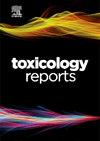Dietary exposure to aflatoxin B1, aflatoxin G1, ochratoxin A, and patulin through fruit juice consumption: A probabilistic assessment of health risk
Q1 Environmental Science
引用次数: 0
Abstract
The present investigation assessed the risk of dietary exposure to four mycotoxins, namely aflatoxin B1 (AFB1), aflatoxin G1 (AFG1), ochratoxin A (OTA), and patulin (PAT) via fruit juice consumption for Iranian consumers. In 96 fruit juice samples obtained from Iran market, mycotoxins levels were determined using liquid chromatography-tandem mass spectrometry. Also, probabilistic health risk assessment was conducted in terms of tolerable daily intake percentage (%TDI) and under cancer risk scenarios. The average concentrations of mycotoxins in the fruit juice samples did not vary significantly among the analyzed samples. The highest mean total level of AFB1 and AFG1was observed in sour cherry, and that of OTA and PAT in pomegranate and apple juice samples. The sour cherry juice demonstrated the highest %TDIs for AFB1 and AFG1 at 50th, 80th, and 95th centiles, while pomegranate juice and apple juice were associated with the highest %TDIs for OTA and PAT, respectively. Across all fruit juice samples, %TDIs for PAT remained below 1.0 at the three centiles. However, %TDIs for AFB1, AFG1, and OTA exceeded 1.0 at these centiles. Based on Monte Carlo Simulation model used for cancer risk scenario, at these centiles, oral consumption of the analyzed samples poses no carcinogenic risk for exposure to AFB1 and AFG1.
通过饮用果汁摄入黄曲霉毒素B1、黄曲霉毒素G1、赭曲霉毒素A和曲霉素:健康风险的概率评估
本调查评估了伊朗消费者通过食用果汁接触四种霉菌毒素(即黄曲霉毒素 B1 (AFB1)、黄曲霉毒素 G1 (AFG1)、赭曲霉毒素 A (OTA)和棒曲霉素 (PAT))的风险。采用液相色谱-串联质谱法测定了从伊朗市场上获得的 96 个果汁样本中霉菌毒素的含量。此外,还根据每日可容忍摄入量百分比(%TDI)和癌症风险情景进行了概率健康风险评估。在分析的果汁样本中,霉菌毒素的平均浓度差异不大。酸樱桃汁中 AFB1 和 AFG1 的平均总含量最高,石榴汁和苹果汁中 OTA 和 PAT 的平均总含量也最高。酸樱桃汁中第 50、80 和 95 百分位数的 AFB1 和 AFG1 检出率最高,而石榴汁和苹果汁中的 OTA 和 PAT 检出率最高。在所有果汁样本中,PAT 的 %TDIs 在三个百分位数上都保持在 1.0 以下。然而,AFB1、AFG1 和 OTA 的 %TDIs 在这些百分位数上都超过了 1.0。根据癌症风险的蒙特卡罗模拟模型,在这些百分位数下,口服分析样本中的 AFB1 和 AFG1 没有致癌风险。
本文章由计算机程序翻译,如有差异,请以英文原文为准。
求助全文
约1分钟内获得全文
求助全文
来源期刊

Toxicology Reports
Environmental Science-Health, Toxicology and Mutagenesis
CiteScore
7.60
自引率
0.00%
发文量
228
审稿时长
11 weeks
 求助内容:
求助内容: 应助结果提醒方式:
应助结果提醒方式:


